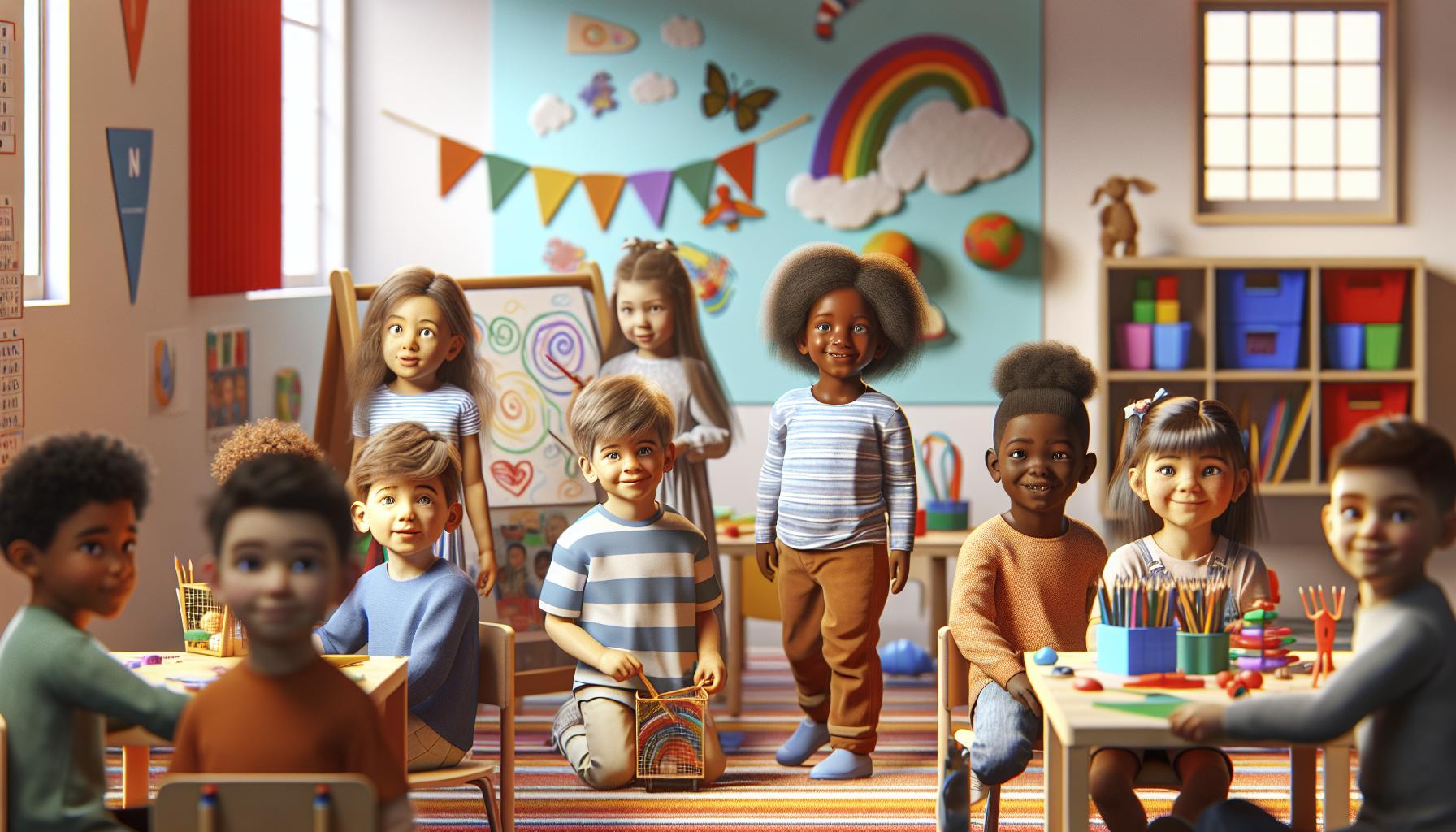The Best Fluffy Pancakes recipe you will fall in love with. Full of tips and tricks to help you make the best pancakes.
Early childhood education lays the foundation for lifelong learning and development. It typically encompasses the early grades where young minds begin to explore and understand the world around them. These formative years are crucial for cognitive, social, and emotional growth.
From preschool through kindergarten and into the early elementary grades, children engage in structured activities that promote essential skills. Educators focus on creating a nurturing environment that fosters curiosity and a love for learning. Understanding the specific grades within early childhood education helps parents and educators support children’s unique developmental needs effectively.
Definition Of Early Childhood Education
Early childhood education defines structured programs for children from birth to age eight. It includes stages such as infant care, preschool, kindergarten, and early elementary grades. These programs develop cognitive, social, emotional, and physical skills. For example, preschool teaches basic literacy and numeracy, while kindergarten introduces structured academic concepts. Early elementary grades build on these foundations with more advanced subjects and interactive activities. High-quality early childhood education provides a nurturing environment that fosters curiosity, creativity, and a love for learning.
| Stage | Age Range | Focus Areas |
|---|---|---|
| Infant Care | 0-2 | Sensory development, bonding |
| Preschool | 3-4 | Basic literacy, numeracy, social skills |
| Kindergarten | 5-6 | Structured academics, motor skills |
| Early Elementary | 7-8 | Advanced literacy, math, critical thinking |
Early childhood education ensures children receive comprehensive support during their formative years, laying the groundwork for lifelong learning and development.
Age And Grade Levels

Early childhood education encompasses various age groups and grade levels, each targeting specific developmental milestones. Understanding these distinctions aids parents and educators in supporting children’s growth effectively.
Preschool (Pre-K)
Preschool, commonly referred to as Pre-K, serves children aged 3 to 4 years. It focuses on foundational skills in literacy, numeracy, and social interaction. Children engage in activities that promote:
- Basic Literacy: Introduction to letters, sounds, and simple words.
- Numeracy Skills: Counting, recognizing numbers, and basic arithmetic.
- Social Development: Cooperative play, sharing, and communication.
- Motor Skills: Fine and gross motor activities, such as drawing and physical exercises.
Educational programs in Pre-K often incorporate play-based learning to foster creativity and curiosity.
Kindergarten
Kindergarten targets children typically 5 years old and serves as a bridge between preschool and elementary education. It emphasizes structured academic concepts and further development of social and emotional skills. Key areas include:
- Structured Literacy: Reading simple sentences, writing basic words.
- Mathematics: Understanding shapes, patterns, and simple addition.
- Motor Skills: Enhanced coordination through writing and physical activities.
- Social Skills: Building friendships, following instructions, and classroom routines.
Kindergarten prepares children for the more rigorous academic demands of elementary school.
Elementary Grades 1-3
Elementary Grades 1-3 cater to children aged 6 to 8 years. This stage builds on earlier foundations with more advanced academic and critical thinking skills. Focus areas include:
- Advanced Literacy: Reading comprehension, writing paragraphs, and vocabulary expansion.
- Mathematics: Basic arithmetic operations, problem-solving, and introduction to multiplication.
- Science and Social Studies: Basic concepts in biology, earth science, history, and geography.
- Critical Thinking: Encouraging curiosity, asking questions, and exploring ideas.
Educational activities become more structured, promoting independent learning and preparation for higher academic levels.
Curriculum And Learning Objectives
Early childhood education curricula are structured to support the developmental stages of children aged 3 to 8 years. Each educational level—preschool, kindergarten, and early elementary grades—has specific learning objectives tailored to foster cognitive, social, and emotional growth.
Preschool (Pre-K)
Preschool programs focus on foundational skills through play-based learning. Key curriculum areas include:
- Literacy: Introduction to letters, phonetics, and basic reading skills.
- Numeracy: Counting, number recognition, and simple arithmetic.
- Social Skills: Sharing, cooperation, and following directions.
- Motor Skills: Fine motor activities like drawing and cutting, and gross motor activities such as running and jumping.
- Sensory Development: Activities that stimulate the senses, including tactile and auditory experiences.
Kindergarten
Kindergarten serves as a bridge to formal education, emphasizing structured academic concepts alongside continued social and emotional development. Curriculum objectives include:
- Reading and Writing: Building on letter recognition to form words and simple sentences.
- Mathematics: Basic addition and subtraction, pattern recognition, and problem-solving.
- Science: Introduction to natural phenomena, simple experiments, and observational skills.
- Social Studies: Understanding community roles, family structures, and basic geography.
- Arts and Music: Encouraging creativity through drawing, painting, singing, and instrument play.
Early Elementary Grades (1-3)
Early elementary education builds on previous foundations with more advanced academic and cognitive objectives. Curriculum focuses on:
- Advanced Literacy: Reading comprehension, writing paragraphs, and vocabulary expansion.
- Mathematics: Multiplication, division, fractions, and introduction to geometry.
- Science: Basic biology, earth science, physical science concepts, and scientific methods.
- Social Studies: History basics, cultural studies, and introduction to government structures.
- Critical Thinking: Problem-solving exercises, logical reasoning tasks, and analytical skills development.
- Physical Education: Enhanced motor skills, team sports, and health education.
Learning Objectives Overview
The table below summarizes the key curriculum areas and their corresponding learning objectives across different early childhood education grades:
| Education Level | Curriculum Area | Learning Objectives |
|---|---|---|
| Preschool (Pre-K) | Literacy | Letter recognition, phonetics, basic reading skills |
| Numeracy | Counting, number recognition, simple arithmetic | |
| Social Skills | Sharing, cooperation, following directions | |
| Motor Skills | Fine and gross motor activities | |
| Sensory Development | Tactile and auditory stimulation | |
| Kindergarten | Reading and Writing | Forming words, simple sentences |
| Mathematics | Basic addition/subtraction, pattern recognition | |
| Science | Introduction to natural phenomena, simple experiments | |
| Social Studies | Community roles, family structures, basic geography | |
| Arts and Music | Creativity through drawing, singing, instrument play | |
| Early Elementary (1-3) | Advanced Literacy | Reading comprehension, writing paragraphs, vocabulary expansion |
| Mathematics | Multiplication, division, fractions, introduction to geometry | |
| Science | Basic biology, earth science, physical science concepts | |
| Social Studies | History basics, cultural studies, government structures | |
| Critical Thinking | Problem-solving, logical reasoning, analytical skills | |
| Physical Education | Enhanced motor skills, team sports, health education |
This structured approach ensures that each stage of early childhood education effectively supports the developmental needs of children, preparing them for successful transitions to higher education levels.
Importance Of Early Grades
Early grades significantly influence a child’s development, laying the groundwork for future academic and personal success. They impact several critical areas:
Cognitive Development
- Enhances Problem-Solving Skills: Structured activities encourage children to think critically and solve challenges.
- Promotes Critical Thinking: Introduction of basic academic concepts fosters analytical abilities.
- Develops Memory and Attention: Consistent learning routines improve memory retention and focus.
Social and Emotional Growth
- Fosters Peer Interaction: Engaging with classmates builds teamwork and communication skills.
- Builds Emotional Regulation: Learning to manage emotions aids in developing empathy and resilience.
- Establishes Independence: Guided activities promote self-confidence and autonomy.
Language and Literacy
- Introduces Reading and Writing: Foundational skills in literacy are essential for later academic progress.
- Expands Vocabulary: Storytelling and conversations enhance language proficiency.
- Improves Comprehension: Group discussions and instructions strengthen listening and understanding.
Motor Skills Development
- Develops Fine Motor Skills: Activities like drawing and writing refine hand-eye coordination.
- Enhances Gross Motor Skills: Physical play and exercises improve overall body movement and coordination.
- Supports Balance and Coordination: Movement-based tasks aid in developing physical stability.
Establishing a Learning Foundation
- Prepares for Higher Education: Building essential skills ensures smoother transitions to advanced grades.
- Cultivates Love for Learning: Engaging curricula inspire curiosity and a desire for knowledge.
- Addresses Individual Needs: Tailored support meets each child’s unique developmental requirements.
- Higher Academic Achievement: Early skill development leads to better performance in standardized assessments.
- Improved Social Skills: Strong interpersonal abilities contribute to healthier relationships throughout life.
- Lifelong Learning Adaptability: Early education fosters an enduring capacity for learning and adaptability.
| Area | Key Benefits |
|---|---|
| Cognitive Development | Problem-solving, critical thinking, memory |
| Social & Emotional Growth | Peer interaction, emotional regulation, independence |
| Language & Literacy | Reading, writing, vocabulary, comprehension |
| Motor Skills | Fine and gross motor development, coordination |
| Learning Foundation | Preparation for higher education, love for learning |
| Long-term Benefits | Academic achievement, social skills, adaptability |
Each early grade level builds essential skills, ensuring children are equipped to meet future educational and personal challenges effectively.
Teaching Methods In Early Childhood Education
Play-Based Learning
Play-based learning integrates structured activities with free play, fostering cognitive, social, and emotional development. Children engage in activities that promote problem-solving, creativity, and collaboration. This method supports foundational skills in literacy and numeracy through interactive and enjoyable experiences.
Montessori Method
The Montessori method emphasizes self-directed learning within a prepared environment. Children choose activities that match their interests and developmental stages, encouraging independence and intrinsic motivation. This approach focuses on hands-on learning, sensory exploration, and the development of practical life skills.
Reggio Emilia Approach
The Reggio Emilia approach centers on project-based learning, where children explore topics deeply through inquiry and collaboration. Educators act as facilitators, guiding children to express their ideas through various mediums such as art, music, and movement. This method emphasizes the importance of social interaction and community involvement in the learning process.
HighScope Curriculum
The HighScope Curriculum incorporates active participatory learning, where children have direct choices in their activities. Structured routines and consistent sequences help children develop organizational and planning skills. This approach includes daily planning, work time, and review segments to reinforce learning objectives and assess progress.
Waldorf Education
Waldorf education focuses on holistic development, integrating academic, artistic, and practical activities. The curriculum is designed to align with the developmental stages of children, promoting imagination, creativity, and social responsibility. Emphasis is placed on storytelling, arts and crafts, and experiential learning to enhance emotional and cognitive growth.
Project-Based Learning
Project-based learning involves children in long-term projects that require critical thinking, research, and collaboration. This method encourages children to explore real-world problems, develop solutions, and present their findings. It integrates multiple subjects, enhancing interdisciplinary understanding and practical application of knowledge.
Technology-Enhanced Learning
Incorporating technology in early childhood education supports interactive and personalized learning experiences. Educational software, digital storytelling, and interactive whiteboards facilitate engagement and skill development in areas such as literacy, math, and science. Technology-enhanced learning also prepares children for future digital literacy requirements.
Social-Emotional Learning (SEL)
Social-emotional learning focuses on developing emotional intelligence, empathy, and interpersonal skills. Structured activities and guided interactions help children understand and manage their emotions, build positive relationships, and develop resilience. SEL programs are integrated into daily routines and collaborative projects to support holistic development.
Language and Literacy Programs
Language and literacy programs emphasize early reading, writing, and communication skills. Activities include shared reading, storytelling, phonemic awareness exercises, and interactive language games. These programs aim to build a strong foundation in language arts, facilitating later academic achievement and effective communication.
Science, Technology, Engineering, and Mathematics (STEM)
Early STEM education introduces children to scientific inquiry, technological tools, engineering principles, and mathematical concepts through hands-on activities and experiments. This approach encourages curiosity, analytical thinking, and problem-solving skills, laying the groundwork for future interest and proficiency in STEM fields.
Structured Academic Instruction
Structured academic instruction provides a balanced approach to teaching core subjects such as math, science, and language arts. Clear learning objectives, systematic lesson plans, and regular assessments ensure that children achieve specific educational milestones. This method supports consistent academic progress and prepares children for the transition to higher education levels.
Social Interaction and Collaborative Learning
Social interaction and collaborative learning involve group activities and peer collaboration to enhance social skills and teamwork. Children participate in cooperative games, group projects, and discussions, fostering a sense of community and mutual respect. This method promotes effective communication, conflict resolution, and collective problem-solving abilities.
Physical Activity and Motor Skills Development
Incorporating physical activity into early childhood education supports gross and fine motor skill development. Activities include structured exercises, free play, arts and crafts, and movement-based games. Physical development enhances coordination, strength, and overall health, contributing to holistic child growth.
Arts Integration
Arts integration involves using visual arts, music, dance, and drama to support and enhance learning across various subjects. Creative expression through art activities helps children develop imagination, fine motor skills, and emotional expression. Arts integration also reinforces academic concepts by providing alternative pathways for understanding and engagement.
Culturally Responsive Teaching
Culturally responsive teaching recognizes and incorporates children’s diverse cultural backgrounds into the curriculum. This approach promotes inclusivity, respect, and appreciation for diversity through diverse materials, culturally relevant content, and responsive teaching strategies. It enhances social awareness and prepares children to thrive in a multicultural society.
Differentiated Instruction
Differentiated instruction tailors teaching methods and activities to meet the diverse needs and learning styles of each child. Educators assess individual strengths and areas for growth, providing appropriate challenges and support. This approach ensures that all children can access the curriculum effectively and achieve their full potential.
Outdoor and Nature-Based Learning
Outdoor and nature-based learning utilizes the natural environment as a dynamic classroom. Activities include nature walks, gardening, and environmental exploration, promoting physical health and environmental awareness. This method enhances sensory experiences, curiosity, and a connection to the natural world.
Positive Behavior Support
Positive behavior support emphasizes reinforcing desirable behaviors through rewards and recognition while minimizing negative behaviors. Clear expectations, consistent routines, and positive reinforcement strategies create a supportive and structured learning environment. This approach fosters self-discipline, responsibility, and respectful interactions among children.
Inquiry-Based Learning
Inquiry-based learning encourages children to ask questions, investigate, and explore topics of interest. This method supports critical thinking, research skills, and independent learning by allowing children to pursue their curiosities within a guided framework. Inquiry-based learning fosters a lifelong love for discovery and knowledge acquisition.
Multisensory Instruction
Multisensory instruction engages multiple senses in the learning process, enhancing memory and understanding. Activities incorporate visual, auditory, tactile, and kinesthetic elements to reinforce concepts and skills. This approach caters to varying learning preferences and supports comprehensive cognitive development.
Scaffolding Techniques
Scaffolding techniques provide temporary support to help children achieve tasks they cannot accomplish independently. Educators offer guidance, modeling, and feedback, gradually reducing assistance as children gain competence. This method builds confidence, independence, and mastery of new skills.
Social Stories and Role-Playing
Social stories and role-playing activities teach children appropriate social behaviors and responses in various situations. Through guided narratives and simulated interactions, children practice communication, empathy, and problem-solving skills. This approach enhances social understanding and emotional regulation.
Use of Visual Aids and Manipulatives
Visual aids and manipulatives support concrete understanding of abstract concepts. Tools such as charts, diagrams, blocks, and puzzles make learning interactive and hands-on. This method aids in the development of mathematical, spatial, and cognitive skills by providing tangible representations of ideas.
Buddy Systems and Peer Mentoring
Buddy systems and peer mentoring pair older or more advanced children with younger or less experienced peers. This approach promotes cooperative learning, leadership skills, and a sense of community. Peer interactions facilitate knowledge sharing, mutual support, and social bonding.
Storytelling and Dramatic Play
Storytelling and dramatic play stimulate imagination, language development, and emotional expression. Children engage in narrative creation, role-playing scenarios, and interactive storytelling sessions. This method enhances listening skills, vocabulary, and creative thinking.
Routine and Structure
Establishing routines and structure provides a predictable and secure learning environment. Consistent schedules, clear expectations, and organized activities help children develop time management and organizational skills. This approach fosters a sense of stability and supports smooth transitions between activities.
Hands-On Science Exploration
Hands-on science exploration involves experiments, observations, and interactive activities to teach scientific concepts. Children engage in practical investigations, fostering curiosity and a deeper understanding of the natural world. This method encourages analytical thinking and a scientific mindset.
Music and Movement Integration
Music and movement activities enhance cognitive and physical development through rhythm, dance, and auditory experiences. Children participate in singing, dancing, and playing musical instruments, improving coordination, memory, and auditory processing skills. This approach promotes joy in learning and expressive abilities.
Language Immersion Programs
Language immersion programs teach children a second language through full or partial immersion in the target language. This method enhances bilingualism, cognitive flexibility, and cultural awareness. Children engage in meaningful communication and language activities, facilitating natural language acquisition.
Sensory Play
Sensory play involves activities that stimulate the senses, such as manipulating textures, exploring scents, and experiencing different sounds. This method supports sensory integration, fine motor skills, and cognitive processing. Sensory play provides a foundation for learning through direct sensory experiences.
Reflection and Self-Assessment
Reflection and self-assessment activities encourage children to think about their learning experiences and progress. Children engage in discussions, journaling, and visual representations to evaluate their understanding and identify areas for improvement. This approach fosters metacognition, self-awareness, and a growth mindset.
Integration of Family and Community
Integrating family and community into the learning process enhances relevance and support for children’s education. Activities include family participation events, community projects, and cultural celebrations. This method strengthens home-school connections and reinforces learning in diverse contexts.

